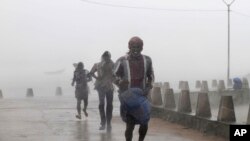A cyclone that India's Meteorological Department described as "very severe" roared across the country's eastern seaboard Sunday, killing at least six people.
Cyclone Hudhud brought heavy rain and winds of up to 195 kilometers per hour as its center came ashore at the port city of Visakhapatnam.
It knocked down power lines and hundreds of trees, and forced public transportation to be suspended.
Rescue workers had been on call ahead of the storm's arrival, and nearly 400,000 people were evacuated from the densely populated areas it hit.
Visakhapatnam is the largest city in Andhra Pradesh and hosts a major Indian naval base.
Mass evacuations of the region’s most vulnerable residents - fishermen and small farmers who live in flimsy mud and thatch huts along the coast, kept most people safe.
They were housed in hundreds of temporary shelters set up in schools and other public buildings in the two states that bore the brunt of the storm - Andhra Pradesh and Orissa.
Storm preparations
Extensive preparations were put in place for Cyclone Hudhud, ironically named after a dainty bird. The cyclone, classified as “severe,” struck a year after another powerful storm hit the region.
Nearly 2,000 members of the National Disaster Response Force stood on standby. Naval ships equipped with divers and helicopters were deployed. Air force teams were positioned for relief work.
The head of India’s Meteorological Department, L.S. Rathore said the cyclone will gradually weaken with wind speeds dropping by the evening. He said the city of Visakhapatnam, would be worst affected.
“The relief and rescue operations, because the aircraft and helicopter operations over the city of Visakhapatnam are very critical and we are expecting [Monday morning] the aircraft will be able to operate because by that time, wind speed will be lesser. ... By that time it will become [a] depression,” Rathore said.
Damage assessment
Authorities will begin assessing the destruction Monday, but they expect massive damage to crops and telecommunication lines from the destructive wind speeds.
India’s eastern region is prone to being battered by powerful storms, and memories of one that killed more than 10,000 people 15 years ago have still not faded.
That disaster prompted authorities to strengthen systems to cope with severe storms. The biggest emphasis is on mass evacuations that have helped minimize casualties.





